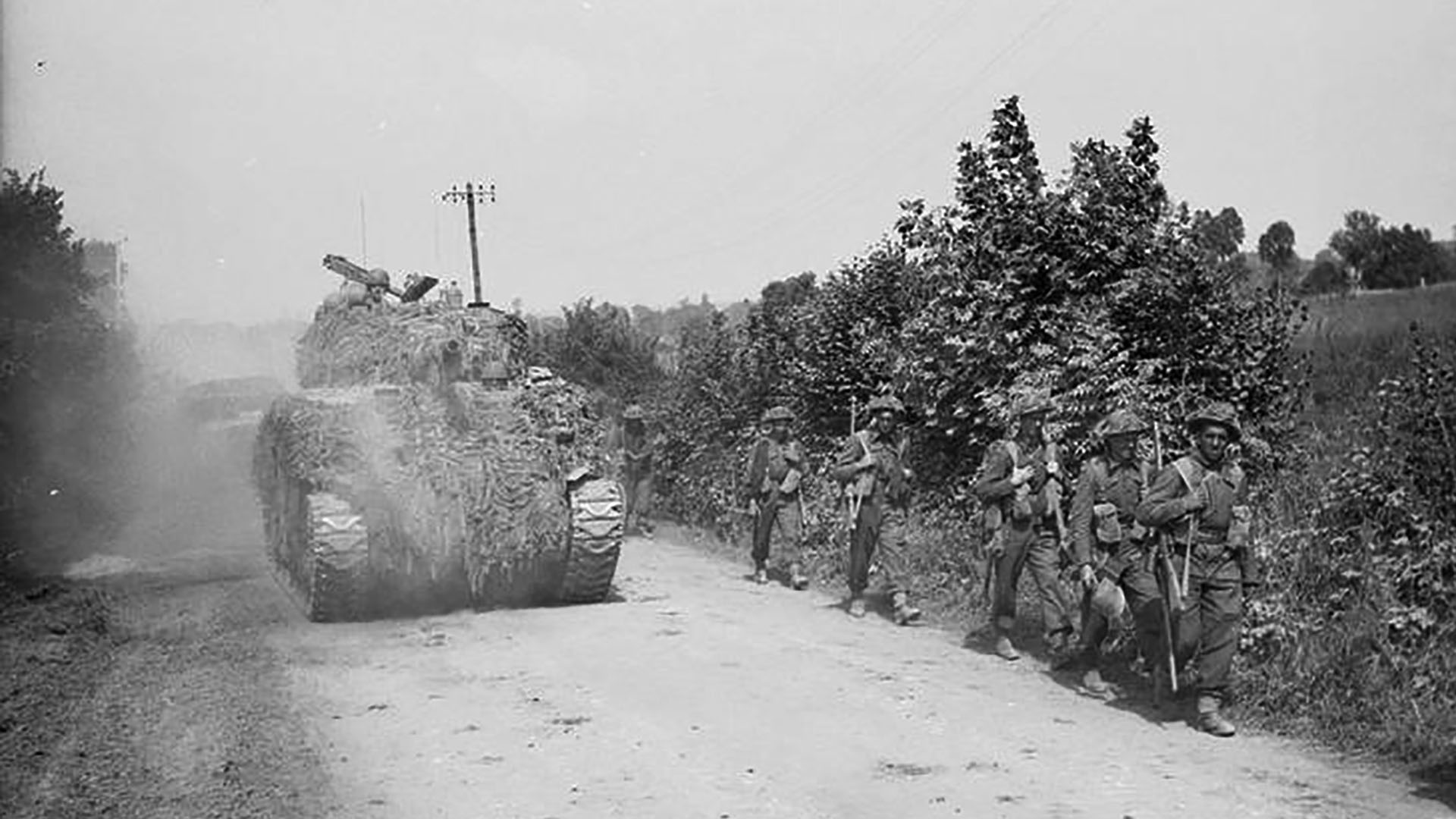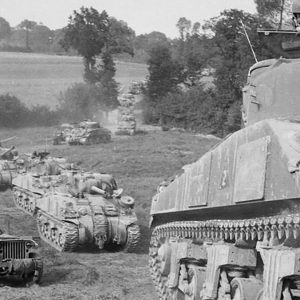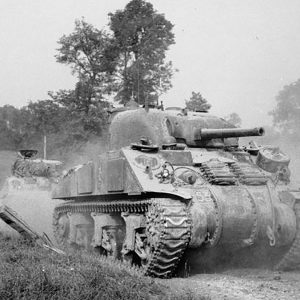Lieutenant Francis Dudley Pakenham McCorkell (258178) served in 2nd Battalion Irish Guards during the Second World War. Born on 22nd April 1923, he was the only son and heir to the estate of Sir Dudley Evelyn Bruce McCorkell M.B.E., K.St.J., J.P. and Lady Helen Elizabeth McCorkell (née Usher) of Ballyarnett, Co. Londonderry.
McCorkell’s father had served as Mayor of the City of Derry from 1929-1935, and later as Lord-Lieutenant of Co. Londonderry from 1957. Educated in England, he attended Seafield Park, Hampshire and Charterhouse School, Godalming, Surrey before enlisting in the Irish Guards at the outbreak of the Second World War. He later completed an Officer’s course at the Royal Military Academy, Sandhurst, Berkshire, England, and rose to the rank of Lieutenant.

Imperial War Museum Photo: (B 8334) (Part of the War Office Second World War Official Collection). A Sherman Tanks and Infantry of 2nd Battalion Irish Guards advance along a road near St. Martin-des-Besaces, Normandy, France on 1st August 1944. Copyright William Fairlie Lawrie - No. 5 Army Film and Photo Section, Army Film and Photographic Unit.
Lieutenant McCorkell died on 6th August 1944 aged 21 years old as the Irish Guards fought during the Battle of Normandy near Le Busq, Normandy, France. The Lieutenant, known as Packy, was a popular and respected officer and several authors have written about his death. In ‘A History of the Irish Guards in the Second World War’, Desmond Fitzgerald writes:
The Germans knew every inch of Le Busq and poured shells into it from the wood to the east. Lieutenant P. McCorkell moved his troop across the road to protect the Coldstreamers. They got into the second field and shot high explosive and Browning into the woods, but it was blind shooting and the German fire continued. Major P. Whitefoord joined them and climbed up on his turret to look over the high hedge. A German machine-gunner saw his head and put a burst into the hedge below it. Patrick Whitefoord slid down his tank with a bullet through his knee. A stream of abuse of the Germans and Normandy poured over the air as he “rang up” for a jeep to fetch him. Captain Michael O’Clock took command of No. 3 Squadron.
Lieutenant McCorkell kept his tank where it was, up against a thick hedge. He himself was standing in the turret directing the fire of his troop on to the muzzle flashes of a battery of mortars. By the one unlucky chance in a thousand a mortar bomb fell straight down the turret and touched off the ammunition. The other tanks’ crews heard a muffled explosion, then, very slowly, the Sherman rose straight in the air, the turret below off and the hull turned an ungainly somersault. It landed on its back and lay there like a beetle, its tracks spinning in the air, till another explosion blew the whole suspension to the other side of the field. A blood-stained book stuck out of the side – it came away in Mick O’Clock’s hand. By the hedge where the tank had been there was a large smoking crater. Lying in the grass near the tank was the Troop Sergeant. He was walking across to talk to Lieutenant McCorkell when the tank blew up; he had to be evacuated as “bomb happy”.
A similar record appears in Edward Roderick Hill’s ‘The Story of the Guards Armoured Division’. One last account comes from fellow Guardsman Sir John Gorman writing in ‘The Times of My Life’:
My close friend Packy McCorkell’s troop was fighting up the next hill in front of my troop and the Nebelwerfers were putting their six close shells all around his tanks, when suddenly we saw a body, arms outstretched, rising from his tank, which had erupted. A mortar shell had fallen through the Commander’s hatch, exploded in the turret, killing all in it and resulting in poor Packy’s body being thrown high in the air.
By now one was getting the understandable dread that one’s luck could not go on. Of the thirty-five officers of 2nd Battalion, over half had already been lost and the odds of the remaining surviving was even money and reducing.
Francis Dudley Pakenham McCorkell’s grave is in Section V, Row F, Grave 13 of St. Charles de Percy War Cemetery, Normandy, France. His name is also on the Charterhouse School War Memorial, Godalming, Surrey, England. His headstone in France bears the inscription:
I have fought a good fight. I have finished my course. I have kept the faith. 2nd Timothy IV.7.



